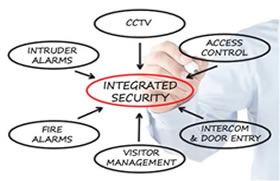integrated security systems

There are many aspects involved in successfully implementing an integrated security solution.
An integrated solution may incorporate access control, video surveillance, intrusion and perimeter control, and mobile security. It may also connect to the human resources database, and incorporate the needs of the risk management, legal, and marketing departments, as well as executive management, to promote the safety of your facility.
Integrating your security solutions also removes the hassle of managing several systems. By integrating your physical and logical systems, you can dramatically simplify access to facilities and networks, saving time and effort by allowing you to monitor all your systems from one place. You can increase surveillance efficiency by tying all your perimeter, intrusion and intelligent video systems together. An integrated system can be scalable for any size organization, while still providing the convenience and increased security that each system would provide individually.
Some benefits to integrating include:
In addition, the most successful integrated security solutions will consider the vision and mission of their organization, and how security needs are integrated through the corporate strategic direction. It is important to consider the needs of each department, and how security can support these groups to achieve a common goal. It is also vital to develop a direct relationship with executive management and the board of directors to integrate corporate and security strategy.
A trusted security advisor can help you consider the various business factors that go into an enterprise-wide security solution, such as reducing the number of systems that are managed and monitored, and helping you to reduce your total cost of ownership. Your security advisor will work with you to design the best solution for your needs and environment, taking into account your unique industry factors and regulatory issues.